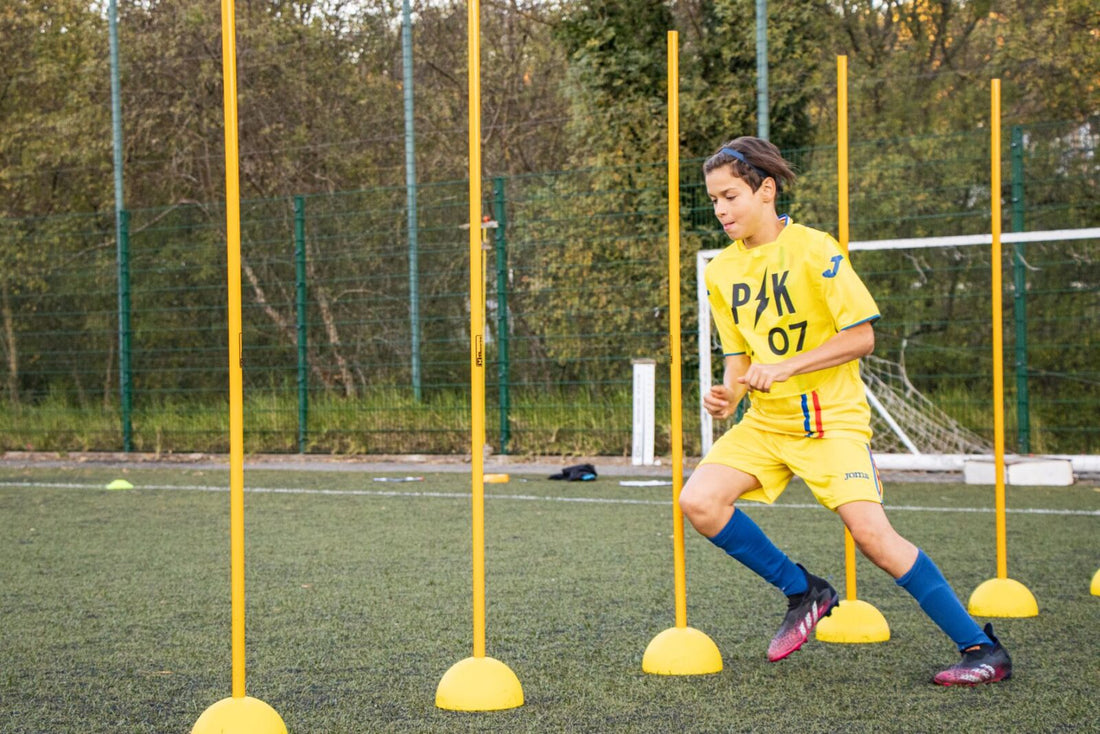
Football: PSK Test (Physical Skills Test)
Share
The PSK Test (Physical Skills Test) in the context of football is an assessment of the specific physical skills required to perform in the sport. This test measures the endurance, speed, agility, strength and technique of players. Here is a step-by-step guide to performing the PSK Test in football.
Preparation
-
Choosing a Location : Find a suitable football pitch with enough space to carry out all activities.
-
Necessary Equipment :
- Stopwatch
- Tape measures or cones to mark distances
- Whistles
- Results Recording Forms
- Soccer balls
- Agility ladders, hurdles and stakes
-
Warm Up and Stretch : Perform a thorough 15-20 minute warm up to prepare your body and reduce the risk of injury. Include dynamic stretching, light jogging, and soccer-specific drills.
Components of the PSK Test in Football
1. Resistance Test (Yo-Yo Intermittent Recovery Test)
Objective : To assess recovery capacity during high-intensity intermittent efforts.
Procedure :
- Mark two cones 20 meters apart.
- The player starts at the first cone and, at the sound signal, runs to the second cone and back.
- After each round trip (totaling 40 meters), the player has a short recovery period.
- The pace increases progressively with the test.
- The test continues until the player fails to maintain the rhythm twice in a row.
- Record the level reached by the player.
2. Speed Test (30 meter sprint)
Objective : To assess maximum speed.
Procedure :
- Mark a starting line and another line 30 meters away.
- The player starts at the starting line.
- At the signal, the player runs at maximum speed to the finish line.
- Use a stopwatch to measure the time from the start until the player crosses the finish line.
- Record time in seconds.
3. Agility Test (Illinois Agility Test)
Objective : To assess agility and the ability to change direction quickly.
Procedure :
- Mark the course according to the Illinois Agility test diagram:
- Four cones forming a rectangle 10 meters long and 5 meters wide.
- Additional cones in the center every 3.3 meters.
- The player starts lying down facing the starting point.
- At the signal, the player stands up and runs around the cones as quickly as possible, following the predetermined route.
- Use a stopwatch to measure the time from the start until the player crosses the finish line.
- Record time in seconds.
4. Explosive Strength Test (Vertical Jump)
Objective : To assess the explosive strength of the legs.
Procedure :
- Use a vertical jump measuring device or a wall with markings.
- The player starts in a stationary position next to the wall or device.
- The player jumps vertically as high as possible, touching the wall or device with his hand.
- Measure the difference between the height reached in the jump and the height of the player in a stationary position.
- Record the heel height in centimeters.
5. Ball Control and Dribbling Test
Objective : To assess the technique of controlling and dribbling the ball at speed.
Procedure :
- Mark a dribbling path with cones spaced 1.5 meters apart.
- The player starts at the starting line with a ball.
- At the signal, the player dribbles the ball along the course, going around the cones at the maximum possible speed.
- Use a stopwatch to measure the time from the start until the player crosses the finish line.
- Record time in seconds and ball control skill.
6. Accuracy Pass Test
Objective : To assess the accuracy of the pass.
Procedure :
- Position targets at different distances and angles.
- The player starts in a determined position.
- The player must pass the ball trying to hit the targets.
- Each target has a specific score based on distance and difficulty.
- Record each player's score based on passing accuracy.
7. Goal kick test
Objective : To assess the strength and accuracy of the kick.
Procedure :
- Position balls in different areas outside the penalty area.
- The player starts in the position determined for each kick.
- The player must kick the ball towards the goal, aiming at different areas of the goal (corners, center, etc.).
- Record the strength and accuracy of kicks based on the target hit and the speed of the kick, if possible, with a speed camera.
Recommended Service
For a more complete and structured training program, we recommend the Soccer Player Training Program . This program offers personalized training for different durations (1 week, 4 weeks and 12 weeks) and includes online support, nutrition plans and more to transform your game.
What is the right training program for me?
We recommend that you check which training program is best suited for you. Find out which training program is right for you where after you fill out the questionnaire we will help you identify the ideal training plan based on your goals and fitness level, ensuring more efficient and targeted development. Check out more details on the website Home Training .
Conclusion
By following these detailed protocols, you can perform the PSK Test in soccer effectively and accurately. These tests help assess players’ physical and technical abilities, providing valuable data to improve individual and team performance. For more guidance on training and fitness, visit Home Workout .



